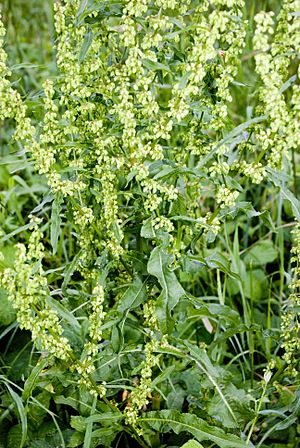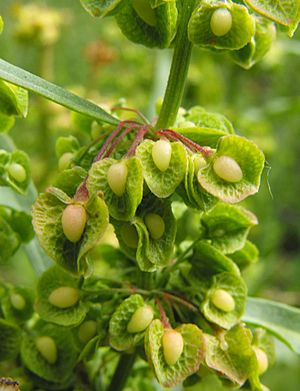Curly dock facts for kids
Quick facts for kids Curly dock |
|
|---|---|
 |
|
| Scientific classification | |
| Genus: |
Rumex
|
| Species: |
crispus
|
Rumex crispus, also known as curly dock or yellow dock, is a plant that comes back every year. It's a flowering plant that belongs to the Polygonaceae family. This plant is originally from Europe and Western Asia.
Contents
What it Looks Like
This plant grows a tall flower stalk, which can reach up to 1.5 meters (about 5 feet) high. It has smooth leaves that grow in a circle close to the ground, called a basal rosette. These leaves have special wavy or curled edges and can grow quite long, from 14 to 24 centimeters (about 5.5 to 9.5 inches).
Flowers and seeds grow in groups on the branched stems of the stalk. The biggest group of flowers is at the very top. The seeds are shiny and brown. Each seed is inside a protective cup-like part of the flower called a calyx. This casing helps the seeds float on water. It also helps them stick to animal fur or wool, which lets them travel to new places. The root of the plant is large, yellow, and grows straight down like a carrot. This is called a taproot.
Where it Grows
Curly dock is common in places like Ireland, the United States, and southern Canada.
How it Lives
Curly dock can grow in many different places. You might find it in disturbed soil, like along roadsides, in fields, or near shorelines. It has spread and now grows wild in many parts of the world where the weather is mild. This includes North America, southern South America, New Zealand, and parts of Australia.
Sometimes, curly dock is considered an invasive species. This means it spreads very easily and can take over areas where other plants grow. Its seeds can mix with crop seeds or stick to clothes, helping it spread even more. In some places, like the UK and parts of the US, it's even called an "injurious weed" or a "noxious weed" because it can cause problems for farming.
Home for Insects
Curly dock is a good plant for some insects, like the Agrotis ipsilon moth, also known as the black cutworm. Adult moths lay their eggs on the low-lying leaves of the curly dock during spring and summer.
Uses and What to Watch Out For
You can eat young curly dock leaves as a wild vegetable. It's best to boil them in a few changes of water. This helps remove some of the oxalic acid they contain. You can also add small amounts of young leaves directly to salads. Once the plant gets older, it becomes too bitter to eat.
Curly dock leaves are full of good things like vitamin A and vitamin C. They also have iron and potassium. The leaves taste a bit tart because of the oxalic acid. While they are tasty, you should only eat them in small amounts. Eating too much can bother your urinary system and might increase the chance of getting kidney stones. If you are a new mother and breastfeeding, be careful, as it might cause a mild laxative effect in your baby.
The seeds of the yellow dock can also be eaten once they are completely dry. These dark brown to black seeds stay on the stalk until spring. You can grind the seeds into a flour that tastes a bit like buckwheat. Some people find it a little bitter, but many enjoy it.
In traditional Western herbal medicine, the root of curly dock is sometimes used to help with anemia, which is when your body doesn't have enough iron. It's often used with stinging nettle. Both the leaves and the root can sometimes act as a mild laxative for some people. This plant might also help with skin problems like itching or sores if used on the skin or taken internally.
Curly dock is also used in homeopathy, which is a different type of medicine. In homeopathy, it's mainly used for breathing problems, especially a tickling cough that gets worse in cold air. It's also mentioned for aches, itching, and helping with swollen lymph nodes.
The Zuni people have traditionally used the powdered root of curly dock. They would make a paste from it to put on sores, rashes, and skin infections. They also made a tea from the root to help with athlete's foot.
See also
 In Spanish: Rumex crispus para niños
In Spanish: Rumex crispus para niños


